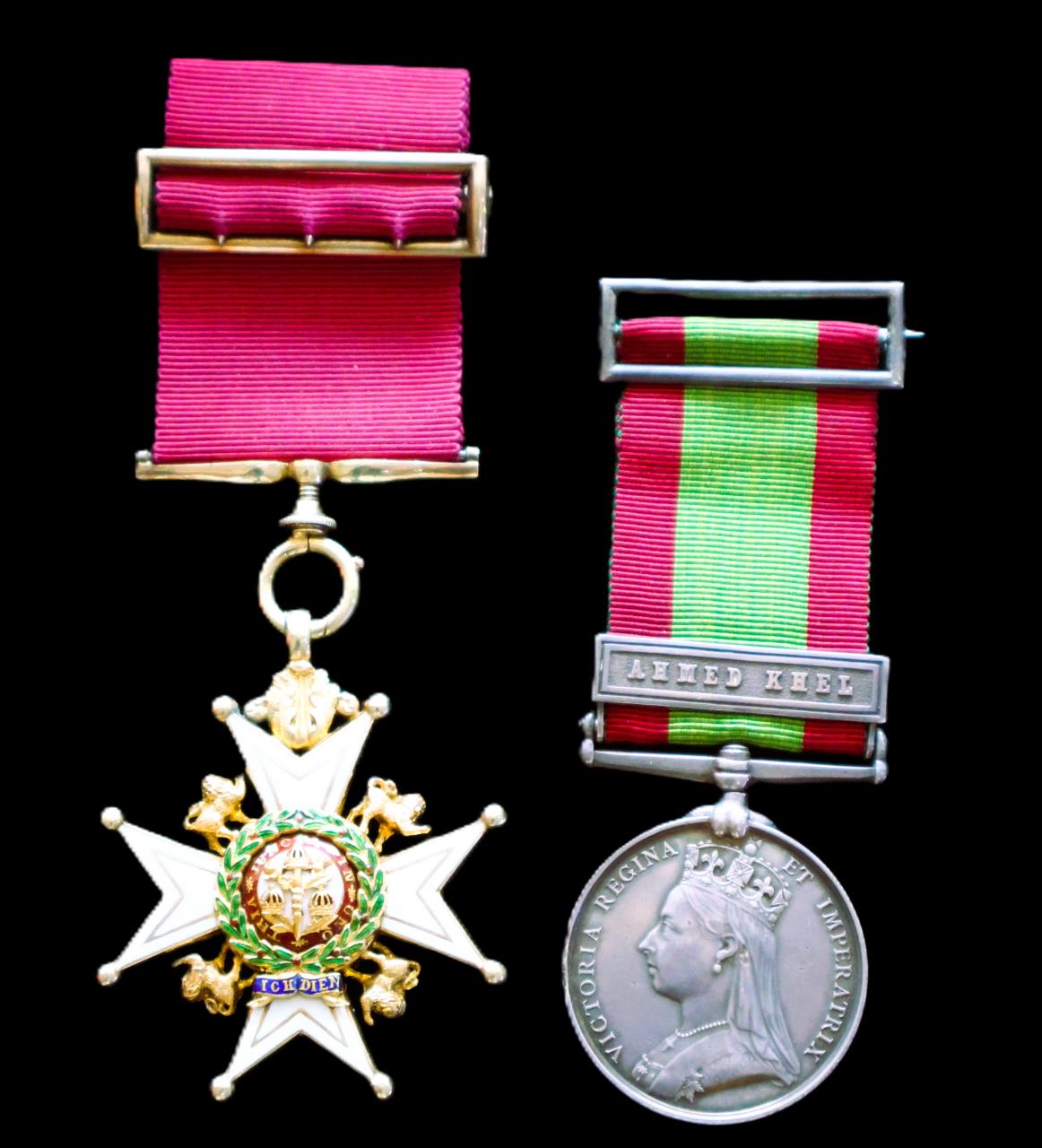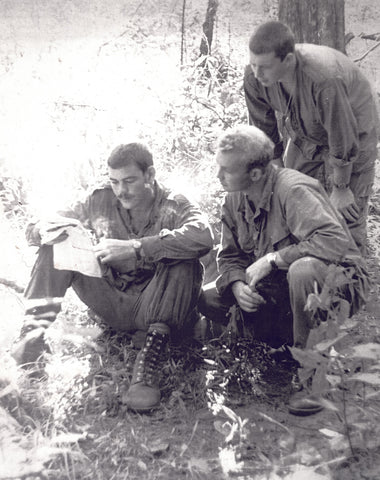Published on Tuesday, 15 April 2025 at 10:30:00 AM

Legendary local military collector, Mr John Burridge MG of John Burridge Military Antiques in Swanbourne, has unearthed a significant piece of history: the military medals belonging to Colonel Edward ‘Ned’ Bruce, the namesake of Nedlands.
Mr Burridge, an avid collector and leading expert in Western Australian military history since his return from the Vietnam War in 1970, had long been on the lookout for Colonel Ned Bruce's medals. His extensive knowledge and keen eye paid off when he spotted them in a UK military catalogue, a discovery he attributes to sheer luck.
Edward Bruce's family history
Ned of Nedlands was the son of Irish-born Colonel John Bruce (1808-1870), who served in Crimea and China, and was a veteran of the Indian mutiny with 42 years of service in the British Army. Colonel John Bruce arrived in Western Australia in 1850 when the convict system was instituted, serving as head of the ‘Pensioner Guard’ – a slightly misleading term for the seasoned veterans who were sent to Australia to guard the convicts in WA's newly established penal station. In 1855, Colonel John Bruce was appointed the Commandant of the Western Australian Military Force, holding the position for 16 years. In 1863, he became a Colonel in the Volunteers Force that he was organising. He also served as Acting Governor of WA. As a philanthropist, he was highly regarded for providing for the care and welfare of old soldiers, and establishing the Pensioner's Benevolent Fund (now Challenge Bank). The success of the system was attributed to 'his wise control and keen interest in the welfare of individuals and their families long after the term of service had expired.' Mount Bruce was named in his honour in 1881.
It was Colonel John Bruce's gift to his son, Edward ('Ned'), of 40 acres of land he had purchased for £200 from Edward Hamersley in 1854, that led to the location being called “Ned’s Lands” which soon evolved into “Nedlands.”
Upon his death in November 1870, the Perth Gazette published a tribute to Colonel John Bruce, noting his independence, honesty, untiring zeal, efficiency, and gallantry and calling him a true friend of Western Australia.
"To the immediate friends of the late deeply lamented Colonel, it must be a solace indeed to know, that during his sojourn in this Colony, he had by his straight forward conduct, honesty of purpose, and uprightness of principle, earned for himself, the respect, esteem and regard of all."
Perth Gazette & W.A. Times, Friday November 11, 1870.
About Edward 'Ned' Bruce
Colonel John Bruce's son Ned lived in Western Australia during his youth, then was sent to Ireland for secondary schooling. After completing his education, he entered military college in Britain and was initially drafted into a British cavalry regiment. He later transferred to the 19th Bengal Lancers infantry unit, serving in Afghanistan during the Second Afghan War. Ned was first commissioned in 1868, and by 1894 he had risen to the rank of Lieutenant Colonel. His active service included wars and large-scale fighting in India, notably participating in Lord Roberts’ historic three-week march to Kandahar in 1880. On the turbulent Indian borders, he also served under another distinguished Commander, Lord Kitchener. Ned commanded operations in the Chitral and was again commended for his service.
Colonel Edward Bruce was mentioned in despatches of 1880, promoted Brevet Major, and awarded the two medals described below and discovered over a century later by Mr Burridge. Ned retired from active service in 1901. He died on 6 June 1911 from heart failure.
Ned’s medals
- Most Honourable Order of the Bath, C.B. (Military), Companions Breast Badge. The inscription 'Tria Juncta in Uno' means Three Joined in One (referring to the union of the Kingdoms of England, Scotland and Ireland in 1801); 'Ich Bien' means I Serve. Awarded in1905.
- Afghanistan 1878-80, one clasp, Ahmed Khel. Awarded 1880.
Upon request, Colonel Edward Bruce’s Medals can be viewed at John Burridge Military Antiques, located at 91 Shenton Road, Swanbourne. The shop is open from 9am to 5pm Monday to Friday, and from 9am to 1pm Saturdays. While you're there, take some time to enjoy a conversation and a laugh with knowledgeable and intriguing Mr Burridge. You'll be glad you stopped by.
Some Bruce family history in Nedlands
Until the years immediately prior to the Great War, Nedlands remained somewhat derelict. The estate was sold for development, and the new owners extended the tramway at their own expense. It was only in later years that the tramway was taken over as a public utility. Though the Bruce family parted with Nedlands before World War 1, they left their mark on the area in numerous street names:
- Bruce Street (named after the Bruce family)
- Edward Street (named after Ned of Nedlands)
- Webster Street (the maiden name of Ned Bruce’s wife, Christiane Webster, daughter of his Commanding Officer, General Webster)
- Thomas Street (named after their second son)
- Stanley and Tyrell Streets (named after their younger sons, both of whom died during WW1).
- Kitchener Street, named after Lord Kitchener (1850-1916) who Ned Bruce served under.
About military medals
Mr Burridge said that various military actions have their highlights, and medals from those actions attract a premium. He explained that it is often “the man behind the medal” that is most important to collectors.
In addition to Ned’s medals, Mr Burridge has also procured the medals for the WA soldier whose statue stands on top of the South African Boer War (1899-1902) memorial at King’s Park.
He offered valuable advice for families: “Never break up a group of medals. Instead, get replica sets made for use by family members at Anzac Day and Remembrance Day services.”
Mr Burridge emphasised the importance of professional mounting, as there is an order of wearing protocol that can change over time. Medals are worn in order of precedence, with campaign medals generally worn before long service and foreign awards. The small metal bars (clasps) worn on the ribbon of a medal are worn in order of the date of qualifying service. When asked how to approach veterans about their medals on Anzac Day, Mr Burridge said, “just ask!”
He also mentioned that replacement medals will only be issued to a living recipient.
For anyone looking to have medals mounted, John Burridge Military Antiques is Western Australia’s oldest medal mounting establishment.
Please note: John Burridge Military Antiques is in no way affiliated with JB Military Antiques in Morley.
About John Burridge MG
John Burridge’s collecting career began at the age of six, influenced by his Uncle Claude, a World War 1 veteran. His father served in World War 2 as an Officer with the 2/2nd Commandos. John is a decorated veteran, having received the Medal for Gallantry (MG) for his service during the Vietnam war.
John volunteered for National Service in 1968. He was in the second intake of A Company and the 12th intake of ’68, and was posted to the 5th Battalion, Royal Australian Regiment, on 9 July 1968. He served 13 months in Vietnam, initially as a machine gunner in 11 Platoon, Delta Company, and later becoming a Corporal and Section Commander.
Mr Burridge's Medal for Gallantry citation reads:
On 4 April 1969, while on Operation Overlander, 11 Platoon came under heavy enemy machine gun and rocket fire from a bunker position at a range of 20 metres.
Two members of Private Burridge's section were killed and the Section Commander wounded.
Private Burridge moved forward, on his own initiative, to a position 15 metres from the enemy and commenced engaging the bunkers.
He maintained his position for over an hour and effectively prevented the enemy from moving to other bunkers on the flanks of the platoon.
His actions drew most of the enemy rocket fire onto his position and as a result he was wounded in both legs.
Despite his wounds and further enemy engagement of his position, Private Burridge continued to fire on the bunkers and restrict the effectiveness of the enemy fire until the remainder of the platoon could move to new positions.
His courage and his complete disregard for his own safety were major factors in preventing further casualties to the platoon and his conduct was an inspiration to all.

John Burridge MG in Vietnam with Jim Ward & Kev Mooney, 1969
The City of Nedlands recognises and honours all veterans for their service.
Lest We Forget.
Back to All News